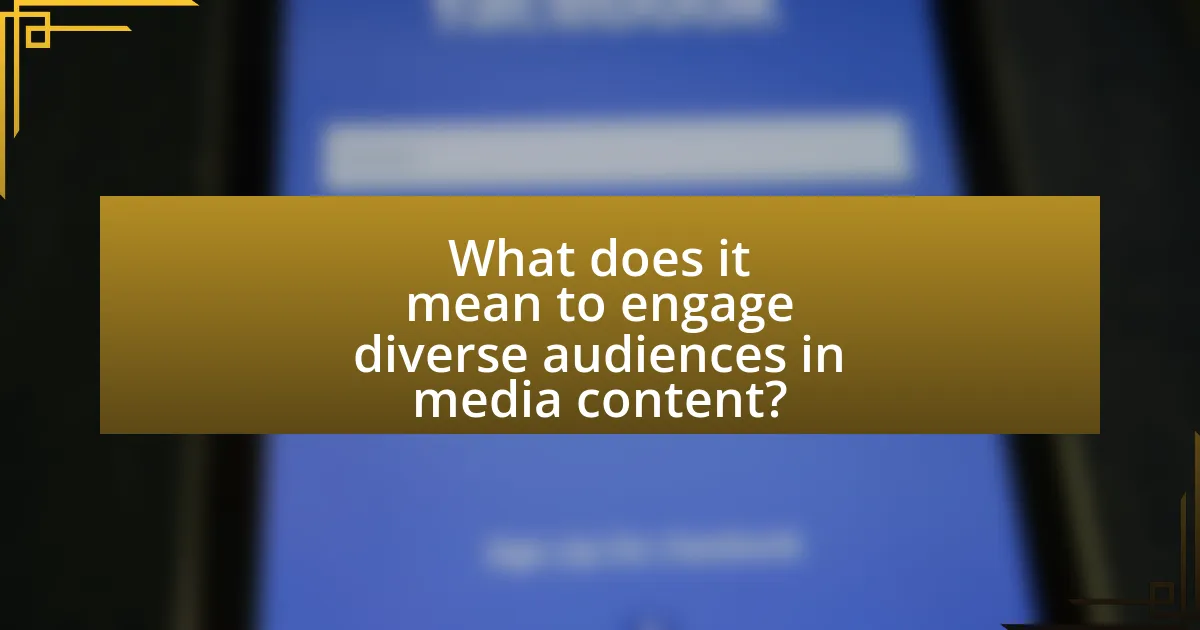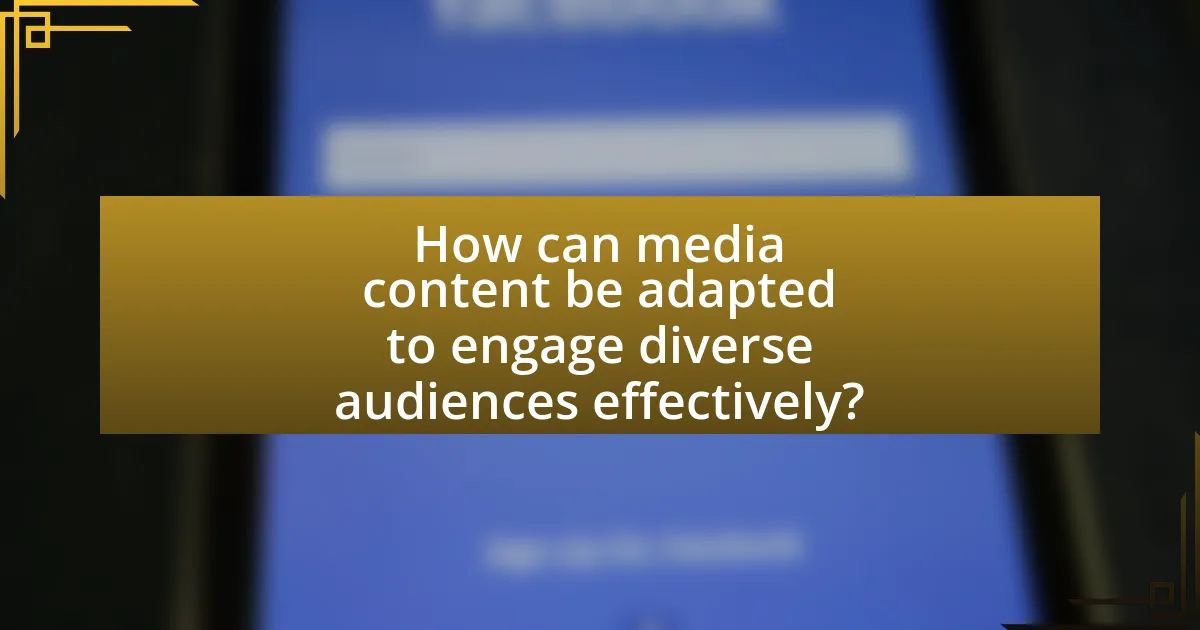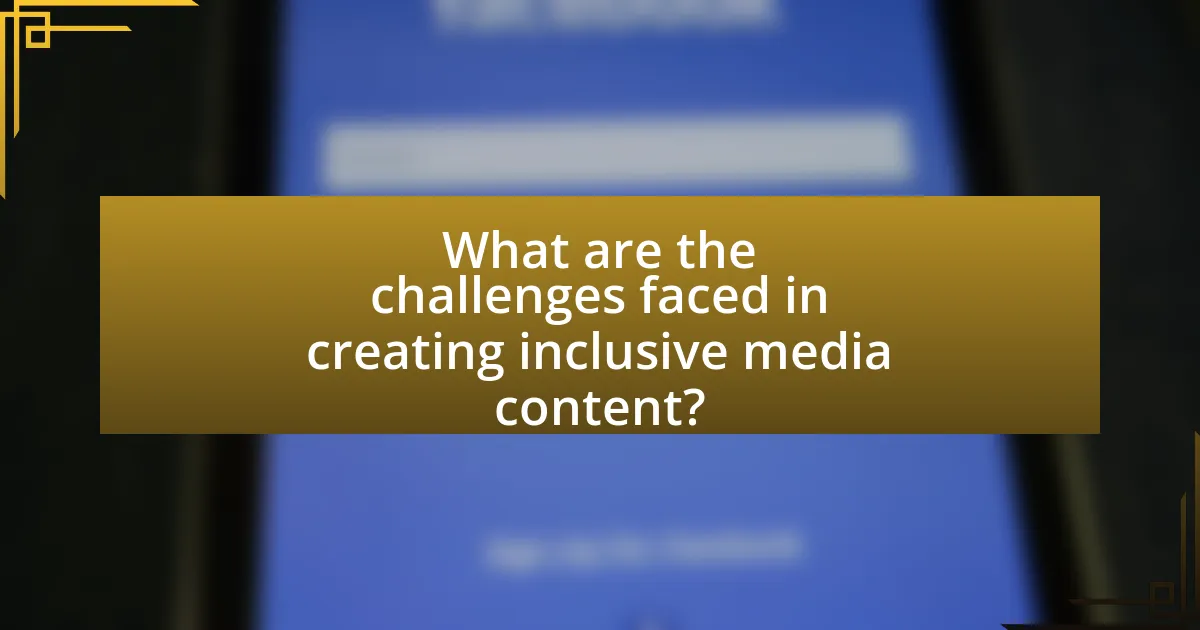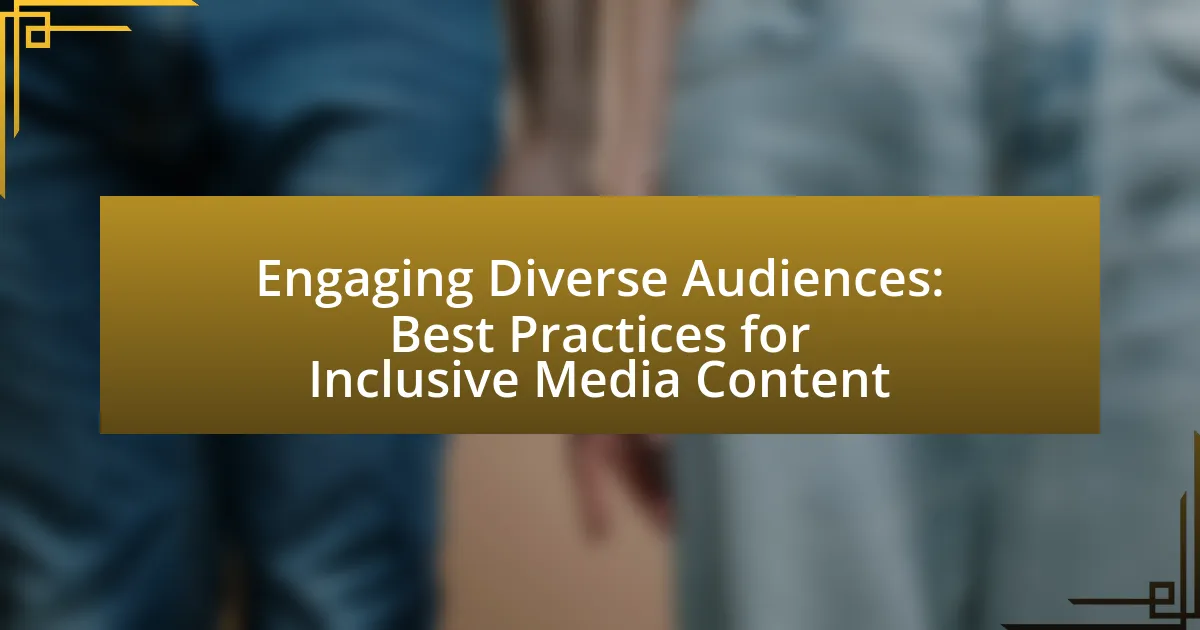Engaging diverse audiences in media content involves creating inclusive media that resonates with individuals from various cultural, ethnic, and social backgrounds. The article outlines the importance of inclusivity in media creation, emphasizing its role in enhancing audience connection, satisfaction, and loyalty. It discusses the characteristics of diverse audiences, the impact of cultural backgrounds and age on preferences, and the significance of audience analysis and feedback in shaping content. Additionally, it highlights best practices for representation, accessibility, and cultural sensitivity, while addressing the challenges and pitfalls of tokenism and stereotypes in media. The article provides practical tips and resources for creators to effectively engage diverse audiences and improve content quality through collaboration and inclusivity.

What does it mean to engage diverse audiences in media content?
Engaging diverse audiences in media content means creating and delivering media that resonates with individuals from various cultural, ethnic, and social backgrounds. This approach involves understanding the unique perspectives, values, and preferences of different groups to ensure that the content is relevant and accessible. Research indicates that inclusive media representation can enhance audience connection and satisfaction, as seen in studies showing that diverse storytelling leads to increased viewer engagement and loyalty. For example, a report by the Annenberg Inclusion Initiative found that films with diverse casts perform better at the box office, highlighting the importance of engaging diverse audiences for both cultural and economic success.
Why is inclusivity important in media content creation?
Inclusivity is important in media content creation because it ensures representation and engagement of diverse audiences. By incorporating various perspectives, media content can resonate with a broader demographic, fostering a sense of belonging and validation among underrepresented groups. Research indicates that inclusive media can enhance audience loyalty and increase viewership; for instance, a study by the Geena Davis Institute on Gender in Media found that films with diverse casts perform better at the box office, demonstrating the financial benefits of inclusivity. Additionally, inclusive content can challenge stereotypes and promote social change, contributing to a more equitable society.
How does inclusivity impact audience perception?
Inclusivity positively impacts audience perception by fostering a sense of belonging and representation among diverse groups. When media content reflects various identities, cultures, and experiences, it enhances relatability and trust, leading to increased engagement. Research indicates that inclusive representation can improve audience satisfaction and loyalty; for instance, a study by the Geena Davis Institute on Gender in Media found that 67% of viewers feel more connected to media that portrays diverse characters authentically. This connection can drive higher viewership and brand loyalty, demonstrating that inclusivity is not only a moral imperative but also a strategic advantage in media engagement.
What are the consequences of excluding diverse voices?
Excluding diverse voices leads to a lack of representation and perpetuates systemic biases in media and society. This absence can result in content that fails to resonate with or address the needs of various demographic groups, ultimately alienating audiences and limiting engagement. Research indicates that diverse teams produce more innovative solutions; for instance, a study by McKinsey found that companies in the top quartile for gender diversity on executive teams were 21% more likely to experience above-average profitability. Therefore, excluding diverse voices not only diminishes the richness of perspectives but also negatively impacts the effectiveness and success of media content.
What are the key characteristics of diverse audiences?
Diverse audiences are characterized by a variety of demographic factors, including age, ethnicity, gender, socioeconomic status, and cultural backgrounds. These characteristics influence their perspectives, preferences, and consumption habits. For instance, according to the U.S. Census Bureau, by 2045, it is projected that the U.S. will become a majority-minority nation, highlighting the increasing importance of understanding and engaging with diverse groups. Additionally, diverse audiences often exhibit varying communication styles and values, which can affect how they respond to media content. Understanding these characteristics is essential for creating inclusive media that resonates with all segments of the population.
How do cultural backgrounds influence audience preferences?
Cultural backgrounds significantly influence audience preferences by shaping values, beliefs, and behaviors that dictate how individuals interpret and engage with media content. For instance, research indicates that audiences from collectivist cultures, such as many Asian societies, often prefer narratives that emphasize community and family, while those from individualistic cultures, like the United States, may favor stories highlighting personal achievement and independence. This distinction is supported by studies such as “Cultural Dimensions in Media Preferences” by Hofstede, which illustrates how cultural dimensions like individualism versus collectivism directly affect content reception and engagement.
What role does age play in audience engagement strategies?
Age significantly influences audience engagement strategies by determining preferences, communication styles, and content consumption habits. Younger audiences, for instance, tend to favor interactive and visually engaging content, often utilizing social media platforms, while older demographics may prefer more traditional forms of communication and in-depth information. Research indicates that 90% of millennials engage with brands through social media, whereas 70% of seniors prefer email communication, highlighting the necessity for tailored strategies that resonate with specific age groups. Understanding these differences allows marketers to create targeted campaigns that enhance engagement and foster loyalty among diverse audiences.
How can media creators identify their target diverse audiences?
Media creators can identify their target diverse audiences by conducting thorough audience research that includes demographic analysis, surveys, and focus groups. This approach allows creators to gather data on various audience segments, including age, ethnicity, gender, and cultural backgrounds. For instance, a study by the Pew Research Center found that understanding the preferences and behaviors of different demographic groups can significantly enhance content relevance and engagement. By analyzing this data, media creators can tailor their content strategies to resonate with specific audience needs and interests, ensuring inclusivity and representation in their media offerings.
What tools and methods can be used for audience analysis?
Audience analysis can be conducted using tools and methods such as surveys, focus groups, social media analytics, and demographic research. Surveys allow for the collection of quantitative data on audience preferences and behaviors, while focus groups provide qualitative insights through discussions. Social media analytics tools, like Hootsuite and Google Analytics, track engagement metrics and audience interactions, revealing trends and interests. Demographic research, utilizing sources like the U.S. Census Bureau, helps identify audience characteristics such as age, gender, and location, which are crucial for tailoring content effectively. These methods collectively enhance understanding of audience needs and preferences, facilitating the creation of inclusive media content.
How can feedback from diverse groups shape content development?
Feedback from diverse groups can significantly shape content development by ensuring that the material resonates with a broader audience and reflects varied perspectives. This inclusivity leads to content that is more relatable and relevant, ultimately enhancing engagement and effectiveness. Research indicates that diverse teams produce more innovative solutions; for instance, a study by McKinsey found that companies in the top quartile for gender diversity on executive teams were 21% more likely to experience above-average profitability. By incorporating feedback from various demographics, content creators can identify blind spots, avoid cultural insensitivity, and create narratives that honor different experiences, thereby fostering a more inclusive media landscape.
What best practices should be followed for creating inclusive media content?
To create inclusive media content, it is essential to prioritize representation, accessibility, and cultural sensitivity. Representation involves showcasing diverse voices and perspectives, ensuring that various demographics, including race, gender, age, and ability, are authentically depicted. Accessibility requires that content is usable by individuals with disabilities, which can include providing captions, audio descriptions, and ensuring compatibility with assistive technologies. Cultural sensitivity entails understanding and respecting the cultural backgrounds of different audiences, avoiding stereotypes, and engaging with community members to ensure accurate portrayals. These practices are supported by research indicating that inclusive content not only broadens audience reach but also enhances engagement and fosters a sense of belonging among viewers.
How can language and imagery be tailored for inclusivity?
Language and imagery can be tailored for inclusivity by using gender-neutral terms, culturally relevant references, and diverse representations. Gender-neutral language avoids assumptions about gender, making communication accessible to all individuals, regardless of their identity. Culturally relevant references ensure that content resonates with various backgrounds, promoting understanding and relatability. Diverse representations in imagery, including individuals of different races, abilities, and body types, reflect the real world and foster a sense of belonging. Research indicates that inclusive language and imagery can enhance audience engagement and satisfaction, as seen in studies by the American Psychological Association, which highlight the positive impact of representation on audience perception and connection.
What are effective strategies for representing diverse perspectives?
Effective strategies for representing diverse perspectives include actively involving individuals from various backgrounds in the content creation process. This approach ensures that multiple viewpoints are authentically represented and reduces the risk of bias. Research indicates that diverse teams produce more innovative solutions and better reflect the audience’s demographics, as seen in a study by McKinsey & Company, which found that companies in the top quartile for ethnic and racial diversity are 35% more likely to outperform their peers in profitability. Additionally, utilizing inclusive language and imagery in media content fosters a sense of belonging among diverse audiences, further enhancing engagement and representation.

How can media content be adapted to engage diverse audiences effectively?
Media content can be adapted to engage diverse audiences effectively by incorporating culturally relevant themes, languages, and perspectives. This approach ensures that various demographic groups see themselves represented and valued in the content. For instance, a study by the Pew Research Center found that 61% of diverse audiences feel more connected to media that reflects their cultural backgrounds. Additionally, utilizing inclusive language and avoiding stereotypes fosters a sense of belonging and respect among viewers. By actively seeking feedback from diverse groups during the content creation process, media producers can refine their strategies to better meet the needs and preferences of all audiences.
What techniques can enhance relatability in media content?
Techniques that can enhance relatability in media content include the use of authentic storytelling, diverse representation, and audience engagement strategies. Authentic storytelling allows creators to connect emotionally with audiences by sharing genuine experiences and relatable narratives. Diverse representation ensures that various backgrounds, cultures, and perspectives are accurately depicted, making content more inclusive and relatable to a broader audience. Audience engagement strategies, such as interactive content and feedback loops, foster a sense of community and allow audiences to see themselves reflected in the media, further enhancing relatability.
How can storytelling be used to connect with diverse audiences?
Storytelling can connect with diverse audiences by incorporating culturally relevant themes and perspectives that resonate with different groups. By using narratives that reflect the experiences, values, and challenges of various communities, storytellers can foster empathy and understanding. Research indicates that inclusive storytelling enhances audience engagement; for example, a study by the University of Southern California found that diverse representation in media leads to increased viewer satisfaction and connection. This approach not only broadens the appeal of the story but also validates the identities of underrepresented groups, making the content more relatable and impactful.
What role does humor play in engaging different demographics?
Humor serves as a vital tool for engaging different demographics by fostering relatability and breaking down social barriers. It enhances communication by creating a shared experience that resonates across cultural and generational lines. Research indicates that humor can increase audience retention and enjoyment, making content more memorable; for instance, a study published in the Journal of Advertising found that humorous advertisements are more likely to be shared and discussed among diverse groups. This ability to connect through humor not only entertains but also encourages inclusivity, as it allows individuals from various backgrounds to find common ground, thereby enhancing overall engagement.
How can technology facilitate inclusive media content creation?
Technology facilitates inclusive media content creation by providing tools that enhance accessibility and representation. For instance, software for closed captioning and audio descriptions allows individuals with hearing or visual impairments to engage with content. Additionally, platforms that support multiple languages enable creators to reach diverse audiences, ensuring that language barriers do not exclude non-native speakers. Research indicates that inclusive design practices can increase audience engagement by up to 30%, demonstrating the effectiveness of these technological solutions in broadening access and participation in media.
What platforms are best for reaching diverse audiences?
Social media platforms such as Facebook, Instagram, Twitter, and TikTok are best for reaching diverse audiences. These platforms have extensive user bases that span various demographics, allowing for targeted outreach. For instance, as of 2023, Facebook has over 2.9 billion monthly active users, with significant representation from different age groups, ethnicities, and locations. Instagram, with its visual content focus, appeals to younger audiences, while TikTok has rapidly gained popularity among Gen Z and millennials, showcasing diverse cultural expressions. Twitter serves as a platform for real-time engagement and discussions, attracting users from various backgrounds. These platforms enable brands and organizations to tailor their messaging and content to resonate with specific audience segments, enhancing inclusivity and engagement.
How can data analytics improve audience engagement strategies?
Data analytics can significantly enhance audience engagement strategies by providing insights into audience behavior and preferences. By analyzing data from various sources, such as social media interactions, website traffic, and user feedback, organizations can identify trends and patterns that inform content creation and distribution. For instance, a study by McKinsey & Company found that companies leveraging data analytics for customer engagement saw a 20% increase in customer satisfaction and a 15% increase in revenue. This demonstrates that data-driven strategies not only improve engagement but also contribute to overall business success.

What are the challenges faced in creating inclusive media content?
Creating inclusive media content faces several challenges, including representation, accessibility, and cultural sensitivity. Representation issues arise when media fails to accurately depict diverse groups, leading to stereotypes and exclusion. Accessibility challenges involve ensuring that content is usable for individuals with disabilities, which often requires additional resources and expertise. Cultural sensitivity is crucial, as misrepresentation or appropriation can alienate audiences and perpetuate harm. These challenges necessitate a commitment to understanding and addressing the needs of various communities to create truly inclusive media.
What common pitfalls should creators avoid?
Creators should avoid the pitfalls of stereotyping, lack of research, and ignoring audience feedback. Stereotyping can lead to misrepresentation and alienation of diverse groups, as evidenced by studies showing that audiences respond negatively to one-dimensional portrayals. Lack of research results in content that may not resonate with or accurately reflect the experiences of different communities, which can diminish engagement and authenticity. Ignoring audience feedback can prevent creators from understanding the needs and preferences of their viewers, ultimately hindering the effectiveness of their content.
How can stereotypes be effectively challenged in media content?
Stereotypes can be effectively challenged in media content by promoting diverse representation and authentic storytelling. By including characters from various backgrounds and experiences, media can dismantle one-dimensional portrayals and provide a more nuanced view of different cultures. Research indicates that diverse representation in media leads to greater audience empathy and understanding, as seen in studies by the Geena Davis Institute on Gender in Media, which found that films with diverse casts perform better at the box office and resonate more with audiences. Furthermore, employing writers and creators from underrepresented groups ensures that narratives are authentic and reflective of real-life experiences, thereby reducing reliance on stereotypes.
What are the risks of tokenism in representation?
Tokenism in representation poses significant risks, including the perpetuation of stereotypes and the undermining of genuine diversity. When individuals from underrepresented groups are included solely for appearances, it can reinforce existing biases rather than challenge them. For instance, a study by the Geena Davis Institute on Gender in Media found that token representation often leads to one-dimensional portrayals that fail to capture the complexity of diverse identities. This superficial inclusion can alienate the very audiences it aims to engage, as they may feel misrepresented or marginalized. Additionally, tokenism can create a false sense of progress, allowing organizations to avoid meaningful change while maintaining the status quo.
How can feedback loops improve inclusivity in media content?
Feedback loops can improve inclusivity in media content by facilitating ongoing dialogue between creators and diverse audiences. This continuous interaction allows media producers to gather insights and perspectives from underrepresented groups, ensuring that their voices are heard and reflected in the content. Research indicates that inclusive media representation can enhance audience engagement and satisfaction, as seen in studies like the 2020 report by the Geena Davis Institute on Gender in Media, which found that diverse representation leads to increased viewership and positive audience reception. By implementing feedback loops, media organizations can adapt their content strategies to better meet the needs and preferences of all audience segments, ultimately fostering a more inclusive media landscape.
What methods can be used to gather audience feedback?
Surveys and questionnaires are effective methods to gather audience feedback. These tools allow organizations to collect quantitative and qualitative data directly from their audience, enabling them to understand preferences, opinions, and experiences. According to a study by the Pew Research Center, 70% of respondents prefer surveys as a means of providing feedback, highlighting their effectiveness in engaging diverse audiences. Additionally, focus groups facilitate in-depth discussions, allowing participants to express their thoughts in a collaborative environment, which can yield rich insights into audience perceptions. Online feedback forms and social media polls also serve as accessible platforms for real-time audience engagement, further enhancing the feedback collection process.
How can creators implement changes based on audience input?
Creators can implement changes based on audience input by actively soliciting feedback through surveys, social media interactions, and direct communication channels. This approach allows creators to gather specific insights about audience preferences and needs, which can then be analyzed to identify common themes or suggestions for improvement. For instance, a study by the Pew Research Center found that 70% of content creators who engaged with their audience reported enhanced satisfaction and loyalty, demonstrating the effectiveness of incorporating audience feedback into content development. By prioritizing audience input, creators can make informed adjustments that resonate with their viewers, ultimately fostering a more inclusive and engaging media experience.
What practical tips can help in creating inclusive media content?
To create inclusive media content, prioritize diverse representation by ensuring that various identities, backgrounds, and experiences are authentically depicted. This approach is supported by research indicating that inclusive representation enhances audience engagement and fosters a sense of belonging among viewers. Additionally, involve individuals from underrepresented groups in the content creation process, as their insights can lead to more accurate and respectful portrayals. Studies show that media produced with diverse teams is more likely to resonate with a broader audience, ultimately driving higher viewership and satisfaction.
How can collaboration with diverse creators enhance content quality?
Collaboration with diverse creators enhances content quality by integrating varied perspectives and experiences, which leads to richer and more relatable narratives. When creators from different backgrounds work together, they contribute unique insights that can resonate with a broader audience, ultimately increasing engagement and relevance. Research indicates that diverse teams produce 35% more innovative ideas, as highlighted in a study by McKinsey & Company, which shows that diversity drives creativity and improves problem-solving capabilities. This collaborative approach not only elevates the content but also fosters inclusivity, making it more appealing to diverse audiences.
What resources are available for learning about inclusivity in media?
Resources for learning about inclusivity in media include online courses, books, and organizations dedicated to diversity in media. Notable online platforms like Coursera and edX offer courses on media representation and inclusivity, often developed by universities and industry experts. Books such as “Media, Diversity, and Social Change” by the Media, Diversity, & Social Change Initiative provide in-depth analysis and case studies. Additionally, organizations like the National Association of Black Journalists and GLAAD offer guidelines, workshops, and resources aimed at promoting inclusivity in media practices. These resources are essential for understanding and implementing best practices in engaging diverse audiences.

Leave a Reply